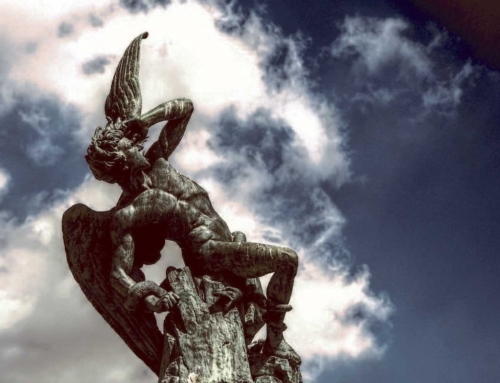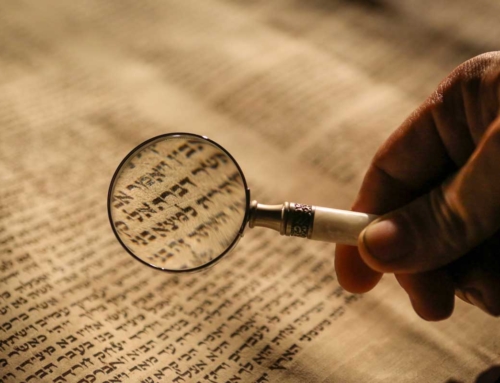I can’t tell you how many times I’ve had to work through my kid’s stories to sort out who did what and who’s shoulders bear the most blame. “Tell me what happened. You, don’t interrupt.” The story is told. “Okay, now you. What happened?” Sometimes one of the kids is lying and I get two completely contradictory stories. I have to figure out which story seems more plausible. Most of the time, the stories fit together, but they’re told differently, usually to make the other kid look more guilty. Eventually, a fuller picture forms and, most of time, everyone gets in trouble.
Stitching the Stories Together
Reading the Gospels can sometimes feel like this. Matthew may leave out a detail that Mark includes, or vice versa. For instance, in Matthew 20:30 we are told about “two blind men sitting by the roadside.” They go on to cry out to Jesus for mercy, and he responds to their please by healing them. In Mark 10 we find the same story, but we are told that, “Bartimaeus, a blind beggar, the son of Timaeus, was sitting by the roadside,” (Mark 10:46). Which is it? Where there two men? Or one? Some scholars and skeptics are quick to cry, “Contradiction!” A more reasoned response is to say that Mark only mentions one blind man even though there were two. Perhaps Bartimaeus was a known to some of Mark’s readers, while the other man was not. Whatever his reason for only mentioning Bartimaeus, it is clear that Mark says nothing like, “There was one, and only one blind man on the road that day.” That would be a contradiction. When we stitch the stories together, like I do with my kids, we see that there were at least two blind men healed that day, one of whom was named Bartimaeus. Mark is no more deceptive or inaccurate in not mentioning the other man than Matthew is in not naming Bartimaeus. No contradiction. No plot to conceal information. Just two true accounts by two writers choosing to include different details.
A More Difficult Discrepency
Not all of the differences in the Gospels are so easy to “stitch together.” One such difficult discrepancy that scholars have spilled much ink over is the chronology of the last week of Jesus’ life when John’s account is compared to the other three Gospel writers. John is fond of giving his readers chronological markers throughout his Gospel. Notice how many time-markers we find in the first two chapters of John:
The next day he [John the Baptist] saw Jesus coming toward him, and said, “Behold, the Lamb of God, who takes away the sin of the world! (John 1:29)
The next day again John was standing with two of his disciples [one of whom was Andrew], and he looked at Jesus as he walked by and said, “Behold, the Lamb of God!” (John 1:35–36)
So they [Andrew and the other of John’s disciples] came and saw where he was staying, and they stayed with him that day, for it was about the tenth hour. (John 1:39)
The next day Jesus decided to go to Galilee. He found Philip and said to him, “Follow me.” (John 1:43)
On the third day there was a wedding at Cana in Galilee, and the mother of Jesus was there. Jesus also was invited to the wedding with his disciples. (John 2:1–2)
After this he went down to Capernaum, with his mother and his brothers and his disciples, and they stayed there for a few days. (John 2:12)
The Passover of the Jews was at hand, and Jesus went up to Jerusalem. (John 2:13)
Readers of John’s account of the life of Christ should find it difficult to believe that he is unconcerned with the order of events as they really happened. Even more than the other three Gospels, John arranges his account chronologically. Of course, all of the Gospels have a general chronological order. All record his death and resurrection at the end. The two accounts of his birth are early in Matthew and Luke, not in the middle or at the end. Still, many of the events recorded by the synoptic writers are arranged topically or in order to emphasize a theological point. No doubt John does this on occasion, but not as often as the other Gospels. He emphasizes times and places, especially as these relate to important Jewish feasts.
So, when we see an apparent (though, as we will see not real) contradiction between John and the other three Gospel writers concerning the day of Christ’s death, we should not be quick to dismiss John or conclude that this apparent contradiction is real. The essential question is, “Did Jesus die on the day of the Passover feast or the following day?” Scholars have puzzled over this question for quite some time, and I don’t think that I can offer a definitive answer. However, I do hope to show that we have every reason to believe that the differences between John and the other Gospels can be reconciled and the accounts can, to some degree, be “stitched together.”
At issue is John’s explanation for the Jewish leaders’ refusal to enter Pilate’s headquarters:
Then they led Jesus from the house of Caiaphas to the governor’s headquarters. It was early morning. They themselves did not enter the governor’s headquarters, so that they would not be defiled, but could eat the Passover. (John 18:28)
Apparently, on the morning of the day of Christ’s crucifixion, these members of the Sanhedrin were planning to eat the Passover meal. They hadn’t yet celebrated the Feast, so they needed to remain ritually clean. They could not enter Pilate’s headquarters because this would make them unclean. This detail provided by John gives additional weight to Jesus’ death. Though John does not emphasize this in his account of Christ’s crucifixion his timeline has Jesus, “the Lamb of God who takes away the sins of the world,” being killed just outside of Jerusalem as the Passover lambs were being slaughtered nearby in the Temple. It is quite likely, on this account, that those present at Christ’s crucifixion could hear the bleating of the sheep as they were led to slaughter as Jesus cried out “It is finished.” This is a powerful portrait of the substitutionary work of Christ on the cross, even if John is somewhat subtle in his tying of these events together.
However, Matthew, Mark, and Luke tell us that Jesus ate a Passover meal with his disciples the night before (the Last Supper) his death.
Now on the first day of Unleavened Bread the disciples came to Jesus, saying, “Where will you have us prepare for you to eat the Passover?” He said, “Go into the city to a certain man and say to him, ‘The Teacher says, My time is at hand. I will keep the Passover at your house with my disciples.’” And the disciples did as Jesus had directed them, and they prepared the Passover. (Matthew 26:17–19)
And the disciples set out and went to the city and found it just as he had told them, and they prepared the Passover. (Mark 14:16)
And when the hour came, he reclined at table, and the apostles with him. And he said to them, “I have earnestly desired to eat this Passover with you before I suffer. For I tell you I will not eat it until it is fulfilled in the kingdom of God.” (Luke 22:14–16)
The Passover was not like Christmas dinner. Your family may eat on Christmas Eve and mine on Christmas Day. You may have an early lunch and I may have a late dinner. Passover required a Passover lamb, which had to be ritually slaughtered the Temple in Jerusalem. The lamb, in turn, had to be eaten on the day it was slaughtered. The day of Passover was set for Nisan (the name of the month also known as Abib) 15. These were not details that could be ignored. These are commands spelled out quite clearly in God’s Law:
In the first month, on the fourteenth day of the month at twilight, is the LORD’s Passover. (Leviticus 23:5)
On the fourteenth day of the first month is the LORD’s Passover, (Numbers 28:16)
You may not offer the Passover sacrifice within any of your towns that the LORD your God is giving you,but at the place that the LORD your God will choose, to make his name dwell in it, there you shall offer the Passover sacrifice, in the evening at sunset, at the time you came out of Egypt. (Deuteronomy 16:5–6)
You shall not offer the blood of my sacrifice with anything leavened, or let the sacrifice of the Feast of the Passover remain until the morning. (Exodus 34:25)
They shall leave none of it until the morning, nor break any of its bones; according to all the statute for the Passover they shall keep it. (Numbers 9:12)
So, if Jesus ate a Passover meal with this disciples on Thursday evening, how can these members of the Sanhedrin be anticipating Passover on Friday evening? If, according the John’s timeline, the lambs were set to be slaughtered on Friday, how could Jesus eat the Passover the night before?
Skeptics take one of two easy ways out. John was wrong. Or Matthew, Mark, and Luke were wrong. Thinking Christians will want to put in a little more effort. At the very least, we should put in as much effort to reconciling these accounts as I do my children’s stories!
As you might imagine, more than one solution has been set forth. Our task is to choose the most likely solution. In my next article, we’ll take a look at the most common proposals and work to determine which one is the most plausible.




